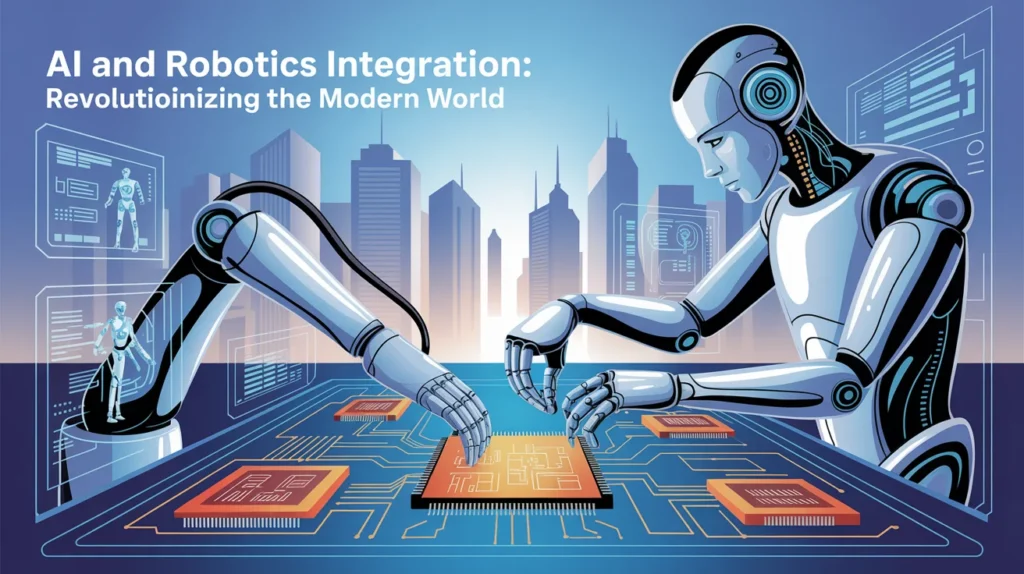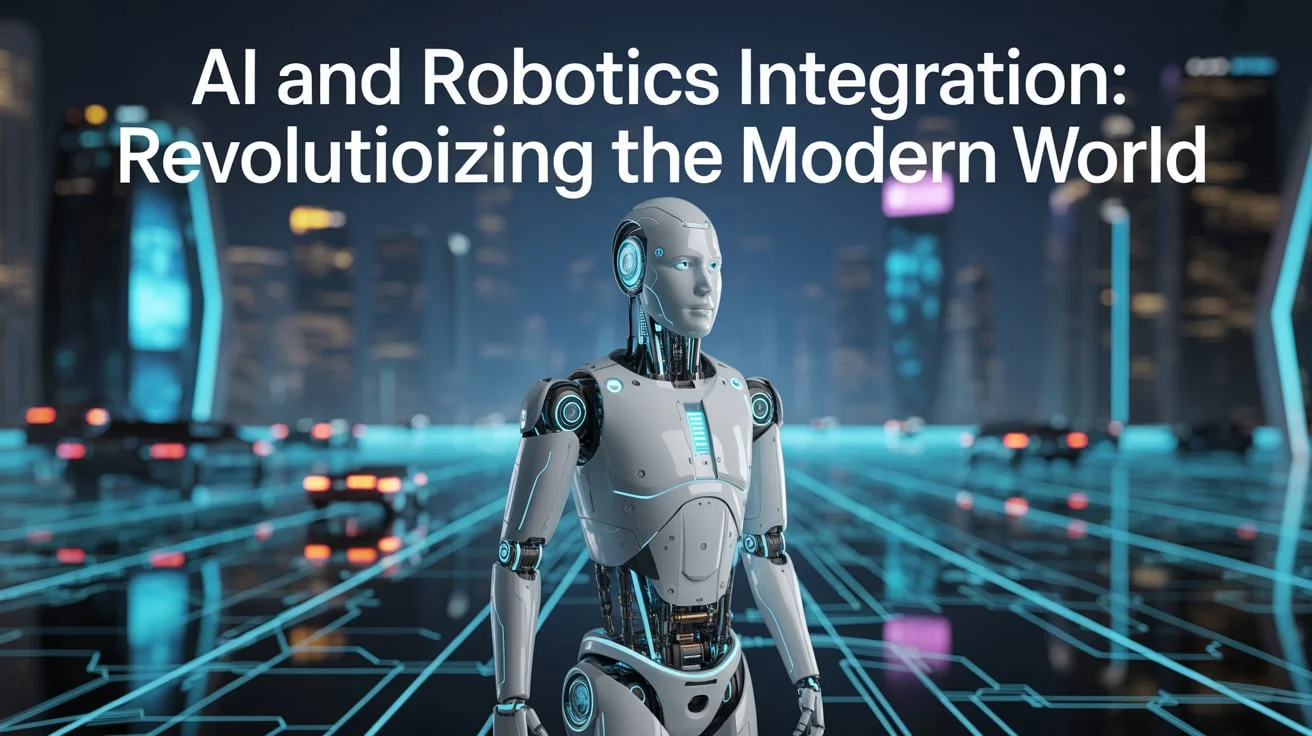AI and robotics integration is no longer futuristic; it’s transforming industries in real time. This synergy is reshaping how humans live, work, and connect, from intelligent assistants in homes to autonomous machines in factories.
In this blog post, we’ll explore how this powerful duo is changing the landscape of automation, why it matters more now than ever, and where it’s headed next. The future is here, and it’s intelligent.
The Core of AI and Robotics Integration
Integrating artificial intelligence with robotics creates machines that can make decisions, learn from data, and adapt to different environments. Robotics provides the body, while AI delivers the brain.
This combination brings machines closer to mimicking human-like behaviour, such as understanding language, recognizing faces, and reacting to changes around them. Instead of simply executing pre-set commands, robots can now reason and act accordingly.
Industries That Are Benefiting the Most
Healthcare, manufacturing, logistics, and agriculture are some industries rapidly adopting AI-powered robotics. In hospitals, robots assist in surgeries and patient monitoring. In agriculture, autonomous drones and machines help optimize crop health and harvest.
These industries are not just saving costs, they’re also improving safety and quality. As automation becomes more intelligent, businesses become more efficient and sustainable.
Key Benefits of AI and Robotics Integration
The combination of robotics with AI brings flexibility and intelligence to automation. This integration leads to wise decisions, reduced downtime, and increased productivity.
Businesses can handle complex tasks that were once impossible for traditional machines. For example, robots in e-commerce warehouses now use AI vision to sort and pack items accurately.
Here are some notable benefits:
- Faster decision-making with real-time data analysis
- Improved accuracy in repetitive or dangerous tasks
- Reduction in human errors and operational costs
- Ability to function in unpredictable environments
- Enhanced customer service with AI-driven bots
Challenges in Artificial intelligence and robotics

While the potential is massive, integrating AI into robotics has hurdles. One major issue is data quality; robots need clean and structured data to learn effectively. Another concern is the ethical impact of replacing human labour.
Developers face technical challenges like ensuring safety, maintaining transparency, and dealing with limited computing power in mobile robotic systems.
Moreover, there’s a growing concern about the misuse of autonomous robots, especially in military and surveillance applications.
How AI Enhances Robotic Capabilities
Artificial intelligence improves how robots sense, decide, and act. Machine learning algorithms allow robots to identify patterns, recognize objects, and learn from previous experiences.
Deep learning enables robots to process images and videos with high accuracy. Natural Language Processing (NLP) lets robots understand human speech and respond contextually.
Future Trends in AI and Robotics
The future of AI and robotics integration looks promising. Researchers are working on general-purpose robots that can adapt across multiple environments. Emotional AI will soon help robots interpret and respond to human emotions.
Meanwhile, collaborative robots or cobots will work side-by-side with humans, not in isolation. These trends will pave the way for more innovative workplaces and homes.
Here are a few upcoming trends:
- Edge AI in robotics for faster on-device decision-making
- Human-robot interaction with emotional intelligence
- Cloud robotics for collective learning and sharing experiences
- Smart exoskeletons powered by AI for human augmentation
- AI in drones for intelligent surveillance and delivery
Real-World Applications: What’s Happening Today
Self-driving cars, warehouse automation, robotic process automation (RPA), and smart home assistants are no longer experimental. These technologies are now being used globally with real results.
In Amazon’s fulfilment centres, robots pick, pack, and ship thousands of items daily. In hospitals, AI robots assist in complex surgeries with unmatched precision. Even at airports, service robots help travellers with directions and information.
Ethical Considerations and the Human Role
As machines become more intelligent, ethical concerns are rising. What if robots take over most jobs? How do we ensure they don’t make biased decisions? Developers and regulators must answer these questions.
The human role is shifting from doing repetitive tasks to managing and training intelligent machines. AI needs humans to set the goals, provide ethical boundaries, and ensure accountability.
Education and Skill Development in the Age of AI
Skills development is key to survival in the era of intelligent automation. Students and professionals need to focus on STEM subjects, especially AI, data science, and robotics.
Governments and institutions must encourage AI-friendly curricula. Workers must embrace lifelong learning to stay relevant in this fast-changing world.
Why Artificial intelligence and robotics Matters
At its core, Artificial intelligence and robotics is about amplifying human capabilities. It allows machines to think, adapt, and collaborate in ways that drive innovation and efficiency.
It’s not just about replacing human labour, it’s about working smarter. When machines handle dangerous or mundane tasks, humans can focus on creativity and strategy.
Conclusion:
AI and robotics integration are changing the face of automation and redefining how we think about machines. It brings together the best of two worlds: intelligence and physical ability.
As we move forward, a balanced approach involving ethics, education, and innovation will shape a future where humans and machines thrive together. Transitioning to this new reality will require cooperation from industries, policymakers, and everyday individuals.
Frequently Asked Questions:
Q: What is Artificial intelligence and robotics?
A: It refers to combining artificial intelligence with robotics to create innovative, adaptable machines.
Q: Which industries use AI-powered robots the most?
A: Healthcare, manufacturing, logistics, and agriculture are leading adopters.
Q: Are robots replacing human jobs?
A: They’re changing job roles, reducing manual task,s but creating new tech-driven opportunities.
Q: Can robots understand human emotions?
A: Emotional AI is developing fast, allowing robots to sense and respond to human emotions.
Q: Is AI in robotics safe?
A: Yes, AI in robotics can be safe and beneficial with proper regulation and ethical frameworks.




